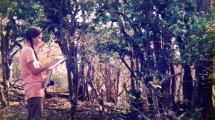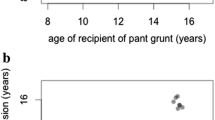Abstract
Observations on dominance rank and kinship of a wild Japanese monkey troop living in Arashiyama, Kyoto, were made as follows: (1) Ranking exists among consanguineous-relatives, and their dominance relation has a great effect on the ranking of individual infants, the influence of which remains after they have grown; (2) With the development of individual infants, a dominance rank is formed by the age of 1 among males and females of the same age according to the ranking of their mothers in the troop, that is, the ranking of consanguineous-relatives, and it remains unchanged through the age of 2; (3) Comparison between individual males and females in ranking becomes difficult to assess after about 3 years of age, though the dominance rank based on mothers' rank still exists among both males and females of the same age. And this dominance' rank becomes very stable; (4) The principle of “youngest ascendency” becomes effective among sisters more than 4 years old. The youngest sister ranks just below her mother and holds the second rank among lineal consanguineous-relatives; (5) Brothers of very close ages temporarily tend toward youngest ascendency when they are 2 or 3 years old, but this relation is soon reversed into the dominance of the elder brother over the younger; (6) Whether male or female, a younger infant of a higher-ranking mother challenges an elder one of a lower-ranking mother and outranks it. In the case of males especially, disparity of age, joint effects of a group, dependent effects on the central part that attend on peripheralization play an important role in outranking.
Similar content being viewed by others
References
Furuya, Y., 1960. An example of fission of a natural troop of Japanese monkey at Gagyusan.Primates, 2(2): 149–180.
——, 1965. Social organization of the crab-eating monkey.Primates, 6(3–4): 285–336.
Hazama, N., 1962. On the weight-measurement of wild Japanese monkeys at Arashiyama.Bull. Iwatayama Monkey Park, No. 1. (in Japanese) Partly translated into English in 1964; Weighing wild Japanese monkeys in Arashiyama.Primates, 5(3–4): 81–104.
Imanishi, K., 1957. Identification: a process of enculturation in the subhuman society ofMacaca fuscata.Primates, 1(1): 1–29. (in Japanese)
Itani, J., 1954. Japanese monkeys in Takasakiyama. In:Nihon Dobutsuki 2,K. Imanishi (ed.) Kobun-sha, Tokyo, 284 pp. (in Japanese)
——, 1957. Personality of Japanese monkeys.Iden, 11(1): 23–29. (in Japanese)
——, 1959. Paternal care in the wild Japanese monkeys.Primates, 2(1): 61–93.
—— et al., 1963. The social construction of natural troops of Japanese monkeys in Takasakiyama.Primates, 4(3): 1–42.
Ito, K., 1958.Comparative Ecology. Iwanami-shoten, Tokyo 366 pp. (in Japanese)
Kawai, M., 1958. On the rank system in a natural group of Japanese monkeys. I. The basic and dependent rank. II. In what pattern does the ranking order appear on and near the test box?Primates, 1(2): 111–148. (in Japanese)
——, 1964.Ecology of Japanese Monkeys. Kawade-shobo, Tokyo, 274 pp. (in Japanese)
——, 1965. Newly-acquired pre-cultural behavior of the natural troop of Japanese monkeys on Koshima island.Primates, 6(1): 1–30.
Kawamura, S., 1958. The matriarchal social order in the Minoo-B troop—A study on the rank system of Japanese macaques.Primates, 1(2): 149–156. (in Japanese)
——, 1959. Individuality in the social behavior of mammals. In:Societies and Individuals in Animals,K. Imanishi (ed.) Iwanami-shoten, Tokyo, pp. 16–30. (in Japanese)
——, 1956. Social organization of the natural group of Japanese macaques —the case of the Minoo-B group.Jap. J. Ecol., 6(2): 45–50. (in Japanese)
Koford, C.B., 1963. Rank of mothers and sons in bands of rhesus monkeys.Science, 141: 356–357.
Mizuhara, H., 1957.Japanese Monkeys. Sanichi-shobo, Kyoto, 220 pp. (in Japanese)
——, 1964. Social changes of Japanese monkeys in the Takasakiyama troop.Primates, 5(1–2): 27–52.
--, 1965. Status organization of wild Japanese monkeys at Takasakiyama. In:Monkeys and Apes,S. Kawamura & J. Itani (eds.) pp. 195–213. (in Japanese)
Nakajima, K., 1958. A wild troop of Japanese monkeys in Arashiyama.Raen, No. 1. (in Japanese)
--, 1964. The lineage of Arashiyama troop. (mimeo.)
Nishida, T., 1966. A sociological study of solitary male monkeys.Primates, 7(2): 141–204.
Sade, D.S., 1965. Some aspects of parent-offspring and sibling relations in a group of rhesus monkeys, with a discussion of grooming.Am. J. Phys. Anthrop., 23: 1–18.
--, 1967. Determinants of dominance in a group of free-ranging rhesus monkeys. In:Social Communication among Primates,S.A. Altmann (ed.) Univ. of Chicago Press, pp. 99–114.
Simonds, P.E., 1965. The bonnet macaque in south India. In:Primate Behavior,I. DeVore (ed.) Holt Rinehart Winston, pp. 175–196.
Sugiyama, Y., 1960. On the division of a natural troop of Japanese monkeys at Takasakiyama.Primates, 2(2): 109–148.
Tokuda, K., 1955. Dominance-subordination relationships in a society of the wild Japanese monkeys.Seibutsu-Kagaku, Iwanami-shoten, Tokyo. (in Japanese)
-- &J. Itani, 1958. The Japanese monkeys in Koshima. In:Nihon Dobutsuki 3,K. Imanishi (ed.) (in Japanese)
Yamada, M., 1963. A study of blood-relationship in the natural society of the Japanese macaque.Primates, 4(3): 43–65.
——, 1966. Five natural troops of Japanese monkeys in Shodoshima Island (I) — distribution and social organization.Primates, 7(3): 315–362.
Author information
Authors and Affiliations
About this article
Cite this article
Koyama, N. On dominance rank and kinship of a wild Japanese monkey troop in Arashiyama. Primates 8, 189–216 (1967). https://doi.org/10.1007/BF01731037
Received:
Issue Date:
DOI: https://doi.org/10.1007/BF01731037




